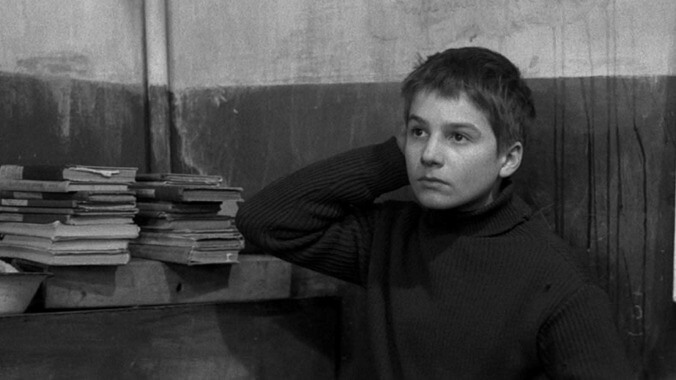Watch This offers movie recommendations inspired by new releases, premieres, current events, or occasionally just our own inscrutable whims. This week: The new directorial debuts The Broken Hearts Gallery and Antebellum have us thinking back on some of our favorite first features.
The 400 Blows (1959)
Orson Welles may have given the debut feature its mythmaking status, but it was the directors of the French New Wave (on whom Welles exerted a considerable influence) that turned it into an institution. Most of them arrived in the French film industry as outsiders, at the head of an era defined by an unprecedented influx of talent in everything from acting to cinematography. A number came from the same group of snotty young film critics that originated the concept of the auteur, and were ideologically committed to the idea of cinema as a personal art form and directors as complete artists with unified world views. What’s more, they had the talent to back up their ambitions. This was evidenced by three game-changing debuts that appeared in the space of a year: François Truffaut’s The 400 Blows, Alain Resnais’ Hiroshima Mon Amour, and Jean-Luc Godard’s Breathless.
Hiroshima Mon Amour and Breathless would become landmarks of movie grammar; the latter, with its surreptitious handheld camerawork, also had a profound effect on how films were made. But The 400 Blows has had its own remarkable influence on film history, both as a model for so many subsequent coming-of-age films and as the earliest example of a vivid, transparently autobiographical work in which the filmmaker’s tastes are as conspicuous as their identification with the protagonist. Godard’s and Resnais’ debuts introduced the world to unique modernist visions, but it was in Truffaut’s movie that the director became the hero.
Set in what was then the present (i.e., the late 1950s), but largely inspired by Truffaut’s childhood and teen years during and after World War II, the film follows an alter ego named Antoine Doinel, played by the 14-year-old Jean-Pierre Léaud, who would grow up to become one of the actors most closely identified with both Truffaut and the New Wave. A habitual truant and troublemaker, Antoine lives in a cramped, dingy Paris apartment with his icy mother (Claire Maurier) and jocular, prank-playing dad (Albert Rémy), who Antoine seems to know is not his biological father. His only escape from the unease of home life and the punishing oppression of school comes in playing hooky with his best friend, René (Patrick Auffay).
Truffaut portrays Antoine’s life with exceptional sensitivity and ambiguity, as well as a current of bitterness that betrays the venomous reputation he developed as a critic. (In fact, he’d been banned from Cannes the year before The 400 Blows had its triumphant premiere at the festival.) If there’s a link between the movie and the kind of attitude exemplified by Truffaut’s classic essay-manifesto “A Certain Tendency Of The French Cinema,” it comes down to its poles of vilification and idealization, with Antoine caught helplessly in between. The enemies are parents, reform schools, and the entire French educational system. The heroes are aspirational: Jean Renoir, Orson Welles, Alfred Hitchcock, and Jean Vigo, who completed his own first (and only) feature, L’Atalante, before dying from tuberculosis.
If Truffaut isn’t as much of an expressionist as the last three, his debut nonetheless represents a remarkable synthesis of blatant influences and personal goals—something that countless first-time filmmakers have tried to replicate since, whether consciously or not. There are, for example, a large number of long takes in the movie, but unlike the theatrically heightened and choreographed drama of a Welles film, what they create is an effortless realism, in part because they involve real locations and inexperienced young actors. The film is also the first example of a debut feature that’s littered with passionate quotations and references, cameos, and obscure in-jokes.
One doesn’t have to get them to get the film., but they are essential to understanding Truffaut as a first-time artist who made a protagonist in his own image: a delinquent, a budding voyeur, and a kid who wants to be loved. That The 400 Blows seems today to be less of a radical departure from narrative expectations than Resnais’ and Godard’s debuts is proof of how deeply its incidental, memoir-like plotting has been internalized by subsequent depictions of adolescence. Not that the movie has lost any of its power to evoke the momentary, escapist happiness and bleak realities of a troubled childhood, whether it’s in Antoine’s ride on an amusement-park centrifuge or in the celebrated finale.
Truffaut would go on to make four more films about the character, straying further and further from autobiography, turning Antoine Doinel into someone who was less a literal alter ego and more a composite of the director’s self-perceived flaws and career-long thematic interest in relationships and longing. Over the course of these movies, Antoine doesn’t grow up to become a glamorously world-famous director. Arguably, he never grows up at all, but remains a wistful, romantic, self-sabotaging overgrown teenager with dreams of becoming a writer. Going back to his first appearance, we find, fully formed, an idea that Truffaut would pass on to generations of filmmakers: that movies can be a popular art made of entirely personal texture.
Availability: The 400 Blows is currently streaming on The Criterion Channel and HBO Max. It is also available for rental or purchase from Amazon, Google Play, iTunes, YouTube, and VUDU.

